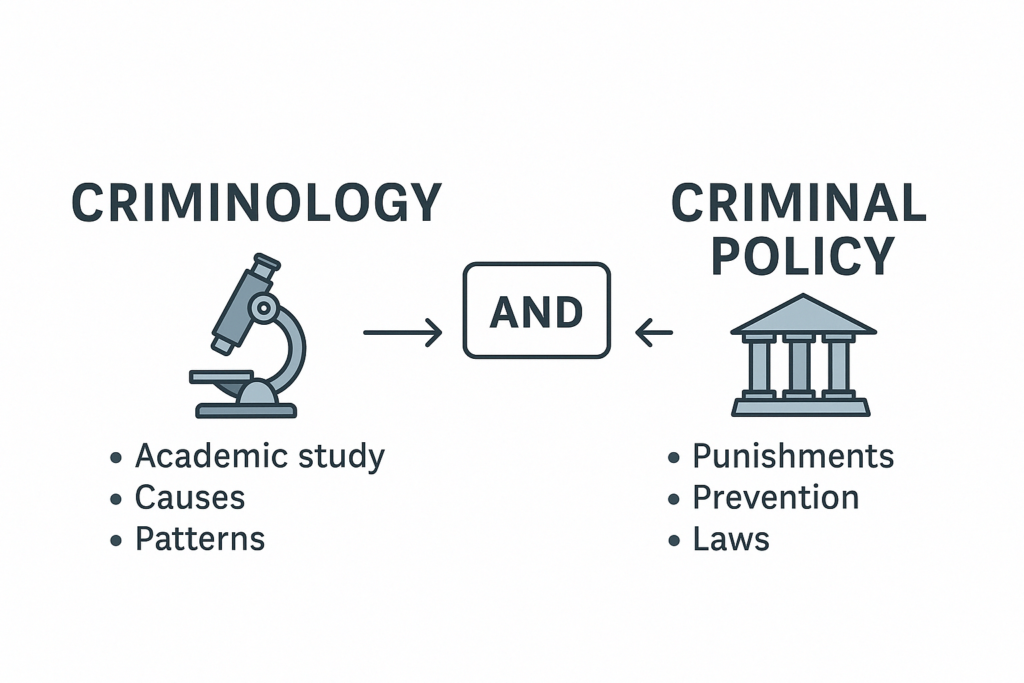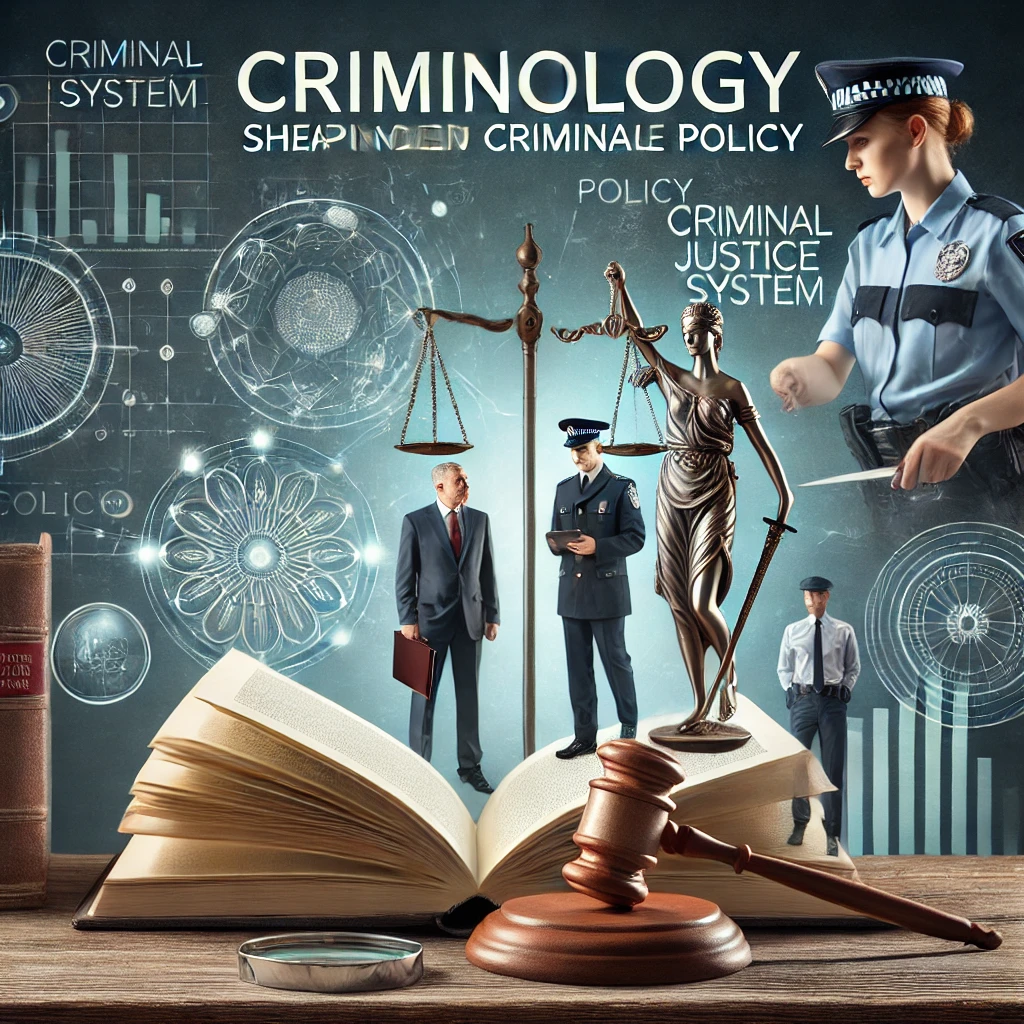Criminal policy and criminology are two interconnected disciplines that play a critical role in understanding, preventing, and responding to crime. While criminology is primarily concerned with the scientific study of crime, criminal behavior, and societal responses, criminal policy focuses on the practical strategies and measures adopted by governments and institutions to manage and reduce crime. Together, these fields form the foundation of modern approaches to criminal justice, combining theoretical insights with actionable solutions.
The Definition and Scope of Criminal Policy
Criminal policy encompasses the measures and strategies designed to prevent crime, maintain public order, and rehabilitate offenders. These measures include legislation, law enforcement practices, judicial processes, and correctional programs. Unlike criminology, which is primarily analytical, criminal policy is inherently prescriptive, aiming to achieve specific outcomes within society.
Criminal policy is influenced by several factors, including:
- Societal Values: Social norms and ethical standards shape the goals and priorities of criminal policy.
- Political Agendas: Policies often reflect the political ideologies of those in power, impacting how crime is defined and addressed.
- Empirical Evidence: Data and research from criminology inform evidence-based policies, ensuring they are effective and just.
The dynamic nature of criminal policy allows it to adapt to societal changes, emerging crime trends, and advancements in criminological research.
The Role of Criminology in Shaping Criminal Policy
Criminology provides the theoretical and empirical foundation necessary for crafting effective criminal policies. By studying the causes of crime, criminologists offer insights into the factors that contribute to criminal behavior. This understanding helps policymakers design interventions that address the root causes of crime rather than merely its symptoms.
Key contributions of criminology to criminal policy include:
- Understanding Crime Patterns: Criminologists analyze data to identify trends, such as the rise in cybercrime or the impact of economic inequality on criminal activity.
- Evaluating Policy Effectiveness: Criminological research assesses the success of policies like community policing or mandatory sentencing.
- Promoting Rehabilitation: Studies in criminology emphasize the importance of addressing psychological and social factors in offender rehabilitation.
For instance, criminological theories like the strain theory and social learning theory have been instrumental in developing community-based programs that target at-risk youth.
Prevention Strategies in Criminal Policy
Prevention is a cornerstone of criminal policy. Effective prevention strategies aim to reduce the opportunities for crime and address the underlying causes. These strategies can be categorized into three levels:
- Primary Prevention: Focuses on creating environments that reduce the likelihood of crime. Examples include improving urban design to enhance visibility and implementing educational programs to teach conflict resolution skills.
- Secondary Prevention: Targets at-risk individuals or groups before they commit a crime. This may involve intervention programs for youth in high-crime neighborhoods or support services for those with substance abuse issues.
- Tertiary Prevention: Aims to prevent reoffending among those who have already committed crimes. This includes rehabilitation programs, parole supervision, and restorative justice practices.
Criminology plays a vital role in designing and evaluating these strategies, ensuring they are evidence-based and contextually appropriate.

The Evolution of Criminal Policy
The evolution of criminal policy reflects changes in societal attitudes, legal frameworks, and scientific understanding. Historically, punitive approaches dominated criminal justice, with a focus on deterrence through harsh penalties. However, the rise of criminology in the 19th and 20th centuries shifted the emphasis towards understanding and addressing the causes of crime.
Key milestones in the evolution of criminal policy include:
- The Classical School: Advocated for proportional punishment and the rationalization of laws, laying the groundwork for modern legal systems.
- The Positivist School: Introduced the scientific study of crime, emphasizing rehabilitation and the role of social and psychological factors.
- Restorative Justice Movement: Focuses on repairing harm caused by crime through dialogue and reconciliation between offenders, victims, and the community.
Today, criminal policy continues to evolve, incorporating insights from criminology, psychology, sociology, and technology to address contemporary challenges.
Challenges in Aligning Criminology and Criminal Policy
Despite their interconnectedness, aligning criminology and criminal policy presents several challenges:
- Political Influence: Policies may prioritize short-term political gains over long-term effectiveness, ignoring criminological evidence.
- Resource Constraints: Limited funding and resources can hinder the implementation of evidence-based policies.
- Public Perception: Public demand for punitive measures can conflict with rehabilitative approaches supported by criminology.
- Complexity of Crime: The multifaceted nature of crime, including cultural, economic, and technological factors, complicates policy design.
Addressing these challenges requires collaboration between criminologists, policymakers, and other stakeholders to ensure that policies are both effective and equitable.
Case Studies: Criminal Policy in Action
- Community Policing: This strategy emphasizes building trust between law enforcement and communities to prevent crime and improve public safety. Criminological research supports its effectiveness in reducing crime and enhancing community relations.
- Drug Courts: These specialized courts focus on rehabilitation rather than punishment for non-violent drug offenders. Studies show that drug courts reduce recidivism and promote recovery.
- Cybercrime Legislation: With the rise of digital crime, criminal policies have adapted to address issues like identity theft and online fraud. Criminology provides insights into offender behavior and prevention strategies.
The Future of Criminal Policy and Criminology
As societies face new challenges, the collaboration between criminology and criminal policy will become increasingly important. Emerging trends include:
- Technology Integration: Utilizing artificial intelligence, data analytics, and surveillance technologies to prevent and solve crimes.
- Global Collaboration: Addressing transnational crimes like human trafficking and cyberterrorism through international cooperation.
- Focus on Equity: Ensuring that criminal policies address systemic inequalities and protect marginalized communities.
By leveraging advancements in criminological research, criminal policy can adapt to the evolving landscape of crime and justice, creating safer and more equitable societies.

Conclusion
Criminal policy and criminology are integral to understanding and addressing the complexities of crime. While criminology provides the theoretical and empirical foundation, criminal policy translates these insights into practical measures that promote public safety and justice. Their collaboration ensures a comprehensive approach to crime prevention, offender rehabilitation, and societal well-being. By continuing to align these disciplines, societies can effectively navigate the challenges of modern crime and create a more just future.

